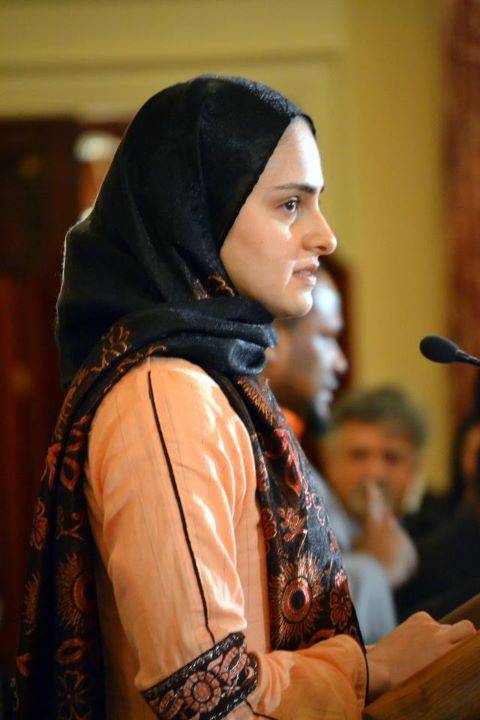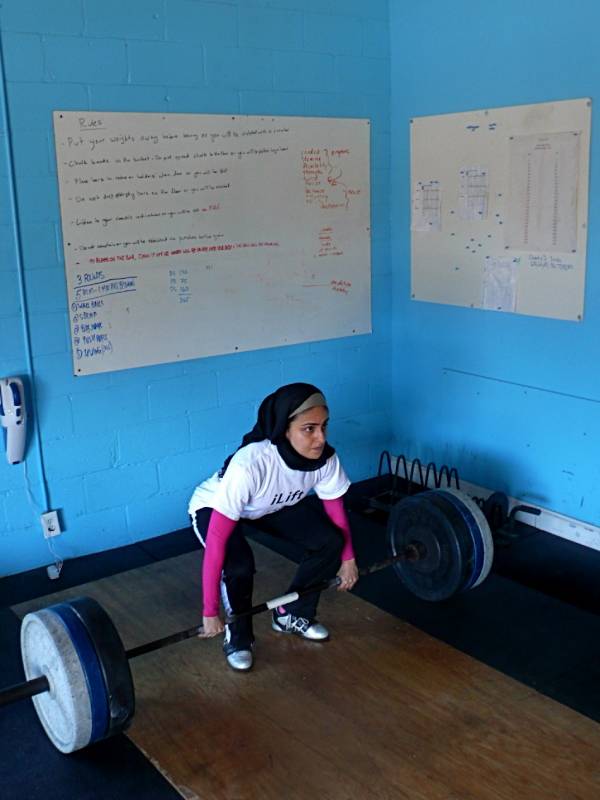This article is one of a two part interview with weightlifter Kulsoom Abdullah:
The challenges of being a practicing Muslim and a serious athlete don’t just stop at controversial competition gear. After a year of campaigning to compete “covered” in the preferred garb of her religion, weightlifter Kulsoom Abdullah is back to her regular training schedule, which looks like that of a “regular” athlete, and yet doesn’t.
Recently, Kulsoom has been juggling her nutritional needs as an athlete with aspects of her religious beliefs. Namely, we are in the middle of Ramadan, a month-long Muslim holiday that requires observers to fast during the daylight hours. This translates into no food or water from sunup until sundown. Kulsoom trains when her gym is open and a coach is present: during the day. This means she trains in a fasted state.
In a blog post on her site Kulsoom describes her process: before sunrise every morning, she drinks as much water as possible and eats some protein and fat, but not many carbs. When she’s actually working out in a fasted state and it’s hot, she just pays close attention to how she’s feeling and uses the breaks between lifts to their greatest advantage. She says it’s a matter of being mindful and not pushing too much. At the time we spoke, she had been fasting for about a week. She had scaled down from six days of training per week to four or five, but she was still able to continue working out.
In the evening Kulsoom first breaks the fast with dates and water, and then after a short wait, she’ll have a balance of protein, fats, and carbs, eschewing gluten and focusing more on veggies and fruits, or perhaps a bit of rice or sweet potatoes. And lots and lots of water.
Kulsoom’s dietary habits during Ramadan have similarities to intermittent fasting, a dietary practice believed to have health benefits for athletes and the general population. It is an example of the notion that Kulsoom’s lifestyle doesn’t actually set her apart as much as one might initially expect. While perhaps she must be a bit more planful during Ramadan, so too must an intermittent faster. She notes that it is not as bad as it might sound to those of us who like to eat whenever we want to.
Perhaps the timing of Ramadan is fortuitous for Kulsoom; given the media attention she had been receiving, she was basically going non-stop for a year. Lately, she is able to dial things back a bit and focus on finding a job in her field of computer engineering. She noted that her academic background is quite complementary to her weight training and her religious practice. She tries to approach each of them in the same way, working hard to do her best and asking questions about the “why” of things in all three areas.
 For Kulsoom, weightlifting plays into all aspects of her personality – the engineer, the philosopher, and the athlete. She wanted to do away with the idea that she was a “delicate butterfly” and that weightlifting is dangerous for her, while she fulfills her scientific bent by maintaining a logbook of her training. On the other hand, Kulsoom also recognizes there will be unknowns sometimes, in all aspects of life. She will always have goals, but the attainment of them is not always linear.
For Kulsoom, weightlifting plays into all aspects of her personality – the engineer, the philosopher, and the athlete. She wanted to do away with the idea that she was a “delicate butterfly” and that weightlifting is dangerous for her, while she fulfills her scientific bent by maintaining a logbook of her training. On the other hand, Kulsoom also recognizes there will be unknowns sometimes, in all aspects of life. She will always have goals, but the attainment of them is not always linear.
Arguably this mindset is appropriate for most would-be athletes; while some may say that there is only one way to do things, the individual would do well to figure out for him/herself what’s best. Some things that work for some people might not work for others, so it is important to get guidance but then do individual research, whether it has to do with diet, spirituality, or any other facet of life.
When asked to identify a favorite lift, Kulsoom distinguished between her best lift, which is the deadlift, and the lifts she gets the most satisfaction out of, which are the snatch and jerk. These latter lifts are harder for her, so she feels more of a sense of accomplishment when she makes progress in these.
From Kulsoom’s story we can learn there is more that unites us than divides us as athletes. While Kulsoom deals with challenges specific to her religion and sport, each of us brings our own considerations, expectations, and limitations to bear on our lives, both inside and outside the gym. Kulsoom noted that just because someone comes from a different culture or chooses to dress differently, that person is not necessarily trying to set him/herself apart. At the end of the day we can all be at the same gym and we can all work out together; there is room for everyone. Perhaps established athletes can take it upon themselves to reach out to different communities to help members of these communities feel comfortable enough entering the gym that they can start to derive the benefits we do of an athletic practice. For many people, just walking into the gym is a big step.
 Kulsoom is not entirely sure what her goals are in the future. “After this past year, it has been pretty busy where I have been non-stop like the Energizer bunny. I do know I will not completely stop weightlifting, because the whole reason I started it was because I like it for exercise and the other benefits.” What is likely is that she will continue to bring the same level of dedication and self-awareness to whatever she decides to do. And in the meantime, perhaps there are other girls, women, boys, and men who will step up to the barbell who might not have before.
Kulsoom is not entirely sure what her goals are in the future. “After this past year, it has been pretty busy where I have been non-stop like the Energizer bunny. I do know I will not completely stop weightlifting, because the whole reason I started it was because I like it for exercise and the other benefits.” What is likely is that she will continue to bring the same level of dedication and self-awareness to whatever she decides to do. And in the meantime, perhaps there are other girls, women, boys, and men who will step up to the barbell who might not have before.
Read part one of our interview with Kulsoom to learn how to paved the way for Muslim women to wear traditional clothing in weightlifting competition.






